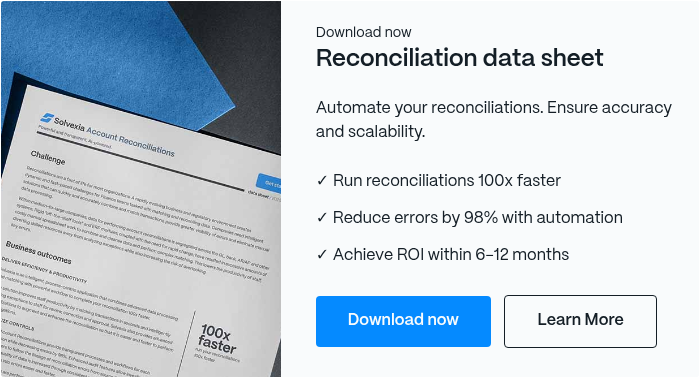Best Bank Financial Reconciliation Tools

As a business leader, it’s up to you to streamline business processes. With financial reconciliation tools, you can maximise your team’s efficiency and make the financial close process seamless. There are many reconciliation tools on the market, so we will break down how they help and which tools are worth considering.
What is Bank Reconciliation Software?
Bank reconciliation software automates the financial close and reconciliation process. It works by providing one centralised system that handles all the account reconciliation processes. First, the system will pull all necessary data together and compare records. The system is able to access historical data, data from the general ledger, ERP, bank statements, credit card statements and more. It will alert your team if any investigation of discrepancies is needed. Then, once the reconciliation is completed, it can be sent and signed to a review for approval. After the approval takes place, the system securely stores the reconciliation in the database, where access to an audit trail is easy to achieve.
Within the system, users have the ability to upload supporting documentations, write comments, review company accounting policies, view the process’ status, and sign off on reconciliations.
Features of Bank Reconciliation Software
With so many account reconciliation software options available, it’s best to know what features you’ll need. Bank reconciliation software should offer the following:
- Account transaction matching: The system can compare internal documents, bank transactions and third party statements to each other. Your team can define matching rules by account or company-wide so the system can easily match and solve differences to their acceptable tolerance levels.
- Reporting: The system can provide your team with matching reports that highlight unmatched records. You can easily compare statements from prior periods to help to understand why the documentation doesn’t match.
- Issue management: You have the option to resolve anomalies manually. Or, you can identify, track and roll forward issues into the next period, if need be.
- Classifications: The system allows you to assign classifications to each record, which will be used during the matching process.
Benefits of Bank Reconciliation Software
Implementing bank reconciliation software will surely boost your team’s productivity. Not only does productivity increase, but you will reduce errors, increase control and much more.
Here are the main benefits of bank reconciliation software:
- Fully automate your bank reconciliations: Of course, the main benefit of bank reconciliation software is that you are able to automate the reconciliation process from beginning to end. From pulling data to comparing records and reviewing the reconciliation documents, the system manages all the heavy lifting. The reconciliation process typically involves more than one person and various sources of data. As such, it’s easy for there to be delays if any single person doesn’t do what they are supposed to. However, the reconciliation process prevents the time it takes to source data from various locations, including spreadsheets on a desktop. The centralised system can access and integrate with other systems to pull needed data and run the reconciliation process.
- Standardise & streamline your reconciliation process: Whether you have several offices or a changing accounting team, the reconciliation process should remain the same across the board. With software like Solvexia, the process is standardised. It exists within the system and can be run iteratively and as frequently as needed. Workflows can be streamlined through an automated approval process to avoid bottlenecks and key person dependencies.
- Reconcile large numbers of transactions quickly: With manual reconciliation, each record has to be matched by hand. Bank reconciliation software can process and match large amounts of records within minutes. This frees up time so that your team can focus on high-level tasks, like performing analysis and making decisions as opposed to manual, repetitive tasks.
- Know your cash position daily: Some companies reconcile daily, weekly, monthly or yearly. While the frequency is up to you, the ease of use of reconciliation software makes it simple to reconcile daily. The main benefit of doing this allows you to know your cash position at any given time. This provides you with the insight you need to make smart financial decisions quickly.
- Reduce errors: Due to the amount of data needed for reconciliation, it’s easy to make manual errors. With reconciliation software, you can forego these errors as the system has a high level of accuracy.
- Enhance internal controls: With bank reconciliation on paper, there’s little control over who can access the documents. With software, you can simply set access controls, so that each necessary party can only view what they are supposed to be able to view. Furthermore, you can also benefit from external controls. The system gives you the ability to pull audit reports and even have them automatically sent to any necessary person. With audit reports, a third party is assured that the process has remained secure and unaltered throughout.

Best Tools for Bank Reconciliation
There are a variety of different software solutions when it comes to bank reconciliation. Most automation solutions provide automated reconciliation as just one of the many offerings within the tool.
Let’s take a look at the main features of some of the most popular bank reconciliation software on the market:
1. Solvexia:
Solvexia is a financial analytical automation tool that can streamline your workflows and boost productivity ten-fold. Its reconciliation tool delivers intelligent finance automation through advanced data processing and matching that reduces the reconciliation process time by 98%. Within seconds, your staff is ready to review exceptions for correction and approval. The transparent process and audit features allow anyone with access an easy way to view what occurred. The cloud-based solution processes over 1 billion transactions per month. Solvexia provides executives with easy-to-read and customisable dashboards, which can also be integrated with other data sources for a robust set of insights.
Features include: smart matching, a unified data platform, executive dashboard, data connectors, actionable insights and transparent processing. Solvexia focuses on making workflow processes seamless so finance teams can focus their time on high-level analytical tasks.
2. BlackLine:
BlackLine offers a cloud-based solution for performing account reconciliation. The software offers the option to use standardised templates, approvals and reviews. The software supports integration to store supporting documentation as well as link procedures into workflows. Solutions include: close process management, process automation, compliance tools and an intercompany hub. BlackLine makes it easy to compare historical account reconciliations to current reconciliations in one view. If reconciliation has happened and account balances change, the system will send an alert via email and decertify the reconciliation. It’s easy to notify team members and collaborate on reconciliations through the comment feature.
3. FloQast:
FloQast is accounting workflow automation that streamlines processes, centralises financial close and automates reconciliations. The system boasts: GL integration, quick implementation, the ability to continue using Excel, a safe and encrypted platform, multi-currency support and the ability to own your own data in document storage systems. FloQast can work with multiple document storage systems, including Google Drive, Dropbox, Microsoft OneDrive, Box, and Egnyte. For general ledger/ERP systems, it’s compatible with Oracle, Microsoft, Sage, Epicor, Quickbooks, Financialforce, and SAP, to name a few.
4. Cashbook:
Cashbook uses cash application automation, bank reconciliation automation, and accounts payable automation to connect your ERP software with your bank accounts. Your workload is reduced because all processes are automated and streamlined. Unlike ERP software, Cashbook included notes, email, workflow capabilities and Excel exports. Both inbound and outbound transactions are recorded in a centralised location.
5. ReconArt:
ReconArt is a cloud-based solution that streamlines the account reconciliation process to boost productivity. It offers: account reconciliation, variance analysis, bank reconciliation, credit card reconciliation, balance sheet reconciliation and close, and enhanced control. ReconArt provides users with migration of accounts into a fully automated solution. It helps to reduce overall operational risk and allows finance teams to focus on important tasks. ReconArt is web-based, which makes deployment simple. Their support team is responsive to customer’s needs.
6. AutoRek:
AutoRek’s provides you with advanced matching capability, case management, management information, and corrective action requests. Since 1994, AutoRek has been helping businesses with data management within the banking, insurance and asset management sectors. Benefits of the software include: onsite or in the cloud, audit trails, granular reporting, and data reconciliation in any format. The customisable dashboard is fully scalable and can reconcile up to 2.4 billion transactions per hour.
7. SmartStream:
One of the many solutions SmartStream offers is reconciliation. Regardless of business size, the system performs transaction matching and investigation. The award-winning TLM technology delivers: reduced operational risk, increased visibility, rapid onboarding, and cost-effective operations. SmartStream features exception management, in which different types of transactions can be viewed in the same workflow to see all exceptions at once. The system will automatically route an exception to the team member or team most equipped to handle it. SmartStream offers Transaction Lifecycle Management (TLM) solutions. With more than 1,500 clients, some of their clients include over 70 of the world’s top 100 banks.
8. Firmway:
Firmway is a cloud-based reconciliation solution out of India. It is available as a web app or for Windows and Mac desktops. Firmway’s features span: multi-user logins, vendor management, accounts payable, accounts receivable, bank reconciliation, email integration and more. The system was designed by Chartered Accountants in India and provides customers with an easy-to-use platform for reconciliation.
9. Sage 50cloud:
Sage is a complete desktop accounting software that provides users with: accounts payable, tax management, payroll management, bank reconciliation, cash management, purchase orders, general ledger, expense tracking and accounts receivable. It can be deployed in any way and payment can be made on a monthly or yearly basis.
The Bottom Line
By implementing automation solutions for the financial reconciliation and finance close, your team can streamline the process seamlessly. With the array of financial reconciliation tools on the market, it’s best to consider what your team’s needs are and find a solution that best suits the budget, deployment preference and scalability you need.
If you’re interested in learning more about Solvexia’s offerings and how we can help your business achieve reconciliation automation, request a free demo.
FAQ
Intelligent reconciliation solution
Intelligent rebate management solution
Intelligent financial automation solution
Intelligent Financial Automation Solution
Intelligent financial automation solution
Intelligent financial automation solution
Intelligent financial automation solution
Intelligent financial automation solution
Intelligent regulatory reporting solution
Free up time and reduce errors
Recommended for you

Request a Demo
Book a 30-minute call to see how our intelligent software can give you more insights and control over your data and reporting.

Reconciliation Data Sheet
Download our data sheet to learn how to automate your reconciliations for increased accuracy, speed and control.

Regulatory Reporting Data Sheet
Download our data sheet to learn how you can prepare, validate and submit regulatory returns 10x faster with automation.

Financial Automation Data Sheet
Download our data sheet to learn how you can run your processes up to 100x faster and with 98% fewer errors.

Financial Automation Data Sheet
Download our data sheet to learn how you can run your processes up to 100x faster and with 98% fewer errors.

Financial Automation Data Sheet
Download our data sheet to learn how you can run your processes up to 100x faster and with 98% fewer errors.

Financial Automation Data Sheet
Download our data sheet to learn how you can run your processes up to 100x faster and with 98% fewer errors.

Financial Automation Data Sheet
Download our data sheet to learn how you can run your processes up to 100x faster and with 98% fewer errors.

Financial Automation Data Sheet
Download our data sheet to learn how you can run your processes up to 100x faster and with 98% fewer errors.

Rebate Management Data Sheet
Download our data sheet to learn how you can manage complex vendor and customer rebates and commission reporting at scale.

Top 10 Automation Challenges for CFOs
Learn how you can avoid and overcome the biggest challenges facing CFOs who want to automate.
.svg)








